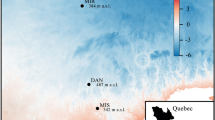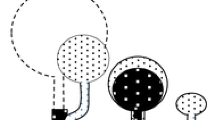Abstract
Key message
Sprouting is a key component of the population dynamics of woody species. Regeneration via sprouting contributes substantially to population growth when resource availability varies.
Abstract
Basal sprouting is an important trait that facilitates the persistence of woody species under different environmental conditions. Environmental heterogeneity can have variable effects on allocation to sexual reproduction and vegetative growth over an individual’s ontogeny; consequently, environmental heterogeneity can influence the dynamics of woody plant populations. However, the effects of environmental factors on the ramet and genet dynamics of woody species have yet to be fully explored. This study investigated the population dynamics of Curatella americana L. (Dilleniaceae), an abundant tree species with a wide geographic distribution. The following hypotheses were tested: (1) density, vital rates and population growth rate are constrained by low rainfall and low soil fertility and (2) ramet production contributes more than seedling production to population growth at low rainfall levels and low soil fertility. Population dynamics were evaluated at two soil types (low and high fertility) over 3 years (2010, 2011 and 2012) with varying rainfall levels (average, average and low rainfall levels, respectively). Both hypotheses were supported. Vegetative growth and the population growth rate were limited by low rainfall and low soil fertility. The survival rates of adults and immature ramets had the largest effect on population growth. Although sprouting was limited by resource availability, this regeneration mode contributed more than seedlings to population growth. Basal sprouting not only ensures species persistence but also, as indicated by these results, permits a species to tolerate a lack of seedling recruitment. Basal sprouting was, therefore, determined to play an important role in the population growth of woody species in heterogeneous environments.





Similar content being viewed by others
References
Alvares CA, Stape JL, Sentelhas PC, Gonçalves JLM, Sparovek G (2013) Köppen’s climate classification map for Brazil. Meteorol Z 22:711–728
Arruda MB, Proença CEB, Rodrigues SC, Campos RN, Martins RC, Martins ES (2008) Ecorregiões, Unidades de Conservação e Representatividade Ecológica do Bioma Cerrado. In: Sano M, Almeida SP, Ribeiro JF (eds) Cerrado: Ecologia e flora, 2nd edn. Embrapa Cerrados, Brasília, pp 231–272
Baruch Z (2011) Leaf trait variation of a dominant neotropical savanna tree across rainfall and fertility gradients. Acta Oecol 37:455–461
Bellingham PJ, Sparrow AD (2000) Resprouting as a life history strategy in woody plant communities. Oikos 89:409–416
Bond JB, Midgley JJ (2001) Ecology of sprouting in woody plants: the persistence niche. Trends Ecol Evol 16:45–51
Brys R, Jacquemyn H, Endels P et al (2005) Effect of Habitat Deterioration on Population Dynamics and Extinction Risks in a Previously Common Perennial. Conserv Biol 19:1633–1643
Canuto JZ (2011) Filogeografia de Curatella americana L. (Dilleniaceae): uma espécie arbórea das savanas da Amazônia e Brasil Central. Dissertation, Instituto nacional de Pesquisa da Amazônia
Carter R, Kim JA, Chambers WB, Teixeira P, Girard P (2004) Inter-linkages Approach for Wetland Management: The case of the Pantanal Wetland. United Nations University Institute of Advanced Studies, Yokohama
Caswell H (2001) Matrix population models: construction, analysis, and interpretation, 2nd edn. Sinauer Associates, Sunderland
Chapin FS, Bloom AJ, Field CB et al (1987) Plant responses to multiple environmental factors. Bioscience 37:49–57
Clarke PJ, Lawes MJ, Midgley JJ et al (2013) Resprouting as a key functional trait: how buds, protection and resources drive persistence after fire. New Phytol 197:19–35
Clark-Tapia R, Mandujano MC, Valverde T et al (2005) How important is clonal recruitment for population maintenance in rare plant species? The case of the narrow endemic cactus, Stenocereus eruca, in Baja California, Mexico. Biol Conserv 124:123–132
Curth MIT, Ghermandi L, Biscayart C (2012) Are Fabiana imbricata shrublands advancing over northwestern Patagonian grasslands? A population dynamics study involving fire and precipitation. J Arid Environ 83:78–85
Dahlgren JP, Ehrlén J (2009) Linking environmental variation to population dynamics of a forest herb. J Ecol 97:666–674
Dalmagro HJ, Lobo FA, Vourlits GL et al (2013) Photosynthetic parameters of two invasive tree species of the Brazilian Pantanal in response to seasonal flooding. Photosynthetica 51:281–294
Dalmagro HJ, Lobo FA, Vourlits GL et al (2014) The physiological light response of two tree species across a hydrologic gradient in Brazilian savanna (Cerrado). Photosynthetica 52:22–35
Davidson EA, Carvalho CJR, Vieira ICG et al (2004) Nitrogen and phosphorus limitation of biomass growth in a tropical secondary forest. Ecol Appl 14:150–163
De Kroon H, Van Groenendael J, Ehrlen J (2000) Elasticities: a review of methods and model limitations. Ecology 81:607–618
Del Tredici P (2001) Sprouting in temperate trees: a morphological and ecological review. Bot Rev 67:121–140
Devillers P, Devillers-Terschuren J (1996) A classification of South American habitats. Report. Institute of Terrestrial Ecology, Institute Royal des Sciences Naturelles de Belgique
Diniz GL, Fonseca M, Campelo JH Jr (2008) Análise harmonica do regime de precipitação em duas localidades da baixada cuiabana. Biomat 18:37–48
Dodd RS, Mayer W, Nettel A et al (2013) Clonal growth and fine-scale genetic structure in Tanoak (Notholithocarpus densiflorus: Fagaceae). J Hered 104:105–114
Empresa Brasileira de Pesquisa Agropecuária (2006) Sistema brasileiro de classificação de solos. Embrapa Solos, Rio de Janeiro
Foldats E, Rutkis E (1975) Ecological studies of Chaparro (Curatella americana L.) and Manteco (Byrsonima crassifolia H.B.K.) in Venezuela. J Biogeogr 2:159–178
Franco M, Silvertown J (2004) A comparative demography of plants based upon elasticities of vital rates. Ecology 85:531–538
Garwood NC (1983) Seed germination on a seasonal tropical forest in Panama: a community study. Ecol Monogr 53:159–181
Gatsuk LE, Smirnova OV, Vorontzova LI et al (1980) Age states of plants of various growth forms: a review. J Ecol 68:675–696
Grady JM, Hoffmann WA (2012) Caught in a fire trap: recurring fire creates stable size equilibria in woody resprouters. Ecology 93:2052–2060
Guedje NM, Lejoly J, Nkongmeneck B et al (2003) Population dynamics of Garcinialucida (Clusiaceae) in Cameroonian Atlantic forests Forest. Ecol Manag 177:231–241
Gurevitch J, Scheiner SM, Fox GA (2009) Ecologia Vegetal. Artmed, Porto Alegre
Hallé F, Oldeman RAA, Tomlinson PB (1978) Tropical trees and forests: an architectural analysis. Springer-Verlag, New York
Herben T, Nováková Z, Klimešová J (2014) Clonal growth and plant species abundance. Ann Bot. doi:10.1093/aob/mct308
Hewitt GM (2004) Genetic consequences of climatic oscillations in the quartenary. Phil Trans R Soc Lond 359:183–195
Hoffman WA, Geiger EL, Gotsch SG et al (2012) Ecological thresholds at the savannah-forest boundary: how plant traits, resources and fire govern the distribution of tropical biomes. Ecol Lett 15:759–768
Hoffmann WA (1999) Fire and population dynamics of woody plants in a neotropical savanna: matrix model projections. Ecology 80:1354–1369
Jeník J (1994) Clonal growth in woody plants: a review. Folia Geobot Phytotx 29:291–306
Loehle C (2000) Strategy space and the disturbance spectrum: a life-history model for tree species coexistence. Am Nat 156:14–33
Lucena IC, Amorim RSS, Lobo FA et al (2014) Spatial heterogeneity of soils of the Cerrado-Pantanal ecotone. Rev Cienc Agron 45:673–682
Mandujano MC, Montana C, Franco M et al (2001) Integration of demographic annual variability in a clonal desert cactus. Ecology 82:344–359
Manly BFJ (2007) Randomization. bootstrap and monte carlo methods in biology, 3rd edn. Chapman & Hall, CRC, Boca Raton
Marcante S, Winkler E, Erschbamer B (2009) Population dynamics along a primary succession gradient: do alpine species fit into demographic succession theory? Ann Bot 103:1129–1143
Matsuchita M, Tomaru N, Hoshino D et al (2012) Factors affecting the production, growth, and survival of sprouting stems in the multi-stemmed understory shrub Lindera triloba. Botany 88:174–184
McCarthy-Neumann S, Ibáñez I (2012) Tree range expansion may be enhanced by escape from negative plant–soil feedbacks. Ecology 93:2637–2649
Medina E, Francisco M (1994) Photosynthesis and water relations of savanna tree species differing in leaf phenology. Tree Physiol 14:1367–1381
Menges ES (1998) Evaluating extinction risks in plant populations. In: Fiedler PL, Kareiva PM (eds) Conservation Biology for the Coming Decade. Chapman & Hall, New York, pp 49–65
Muñoz-Costa A, Calleja-Alarcon JA (2013) Plant size and local abiotic factors determine the intra-specific variation in the multi-stemmed architecture of Prunus lusitanica at the Northeast limit of its global distribution. Forest Sys 22:423–432
Myers N, Mittermeier RA, Mittermeier CG, da Fonseca GAB, Kent J (2000) Biodiversity hotspots for conservation priorities. Nature 203:853–858
Nepstad DC, Tohver IV, Ray D et al (2007) Mortality of large trees and lianas following experimental drought in an amazon forest. Ecology 88:2259–2269
Oborny B, Englert P (2012) Plant growth and foraging for a patchy resource: a credit model. Ecol Model 234:20–30
Portela RCQ, Bruna EM, Santos AM (2010) Demography of palm species in Brazil’s Atlantic forest: a comparison of harvested and unharvested species using matrix models. Biodivers Conserv 19:2389–2403
R Development Core Team (2012) R: A language and environment for statistical computing. R Foundation for Statistical Computing, Vienna, Austria
Sardans J, Rodà F, Peñuelas J (2006) Effects of a nutrient pulse supply on nutrient status of the Mediterranean trees Quercus ilex subsp. ballota and Pinushalepensis on different soils and under different competitive pressure. Trees 20:619–632
Sarukhan J (1974) Studies on plant demography: Ranunculus repens L., R. bulbosus L. and R. acris L. Reproductive strategies and seed population dynamics. J Ecol 62:151–177
Silvertown J (2008) The evolutionary maintenance of sexual reproduction: evidence from the ecological distribution of asexual reproduction in clonal plants. Int J Plant Sci 169:157–168
Silvertown J, Franco M, Mendoza IPA (1993) Comparative plant demography—relative importance of life-cycle components to the finite rate of increase in woody and herbaceous perennials. J Ecol 81:465–476
Soliveres S, De Soto L, Maestre FT et al (2010) Spatio-temporal heterogeneity in abiotic factors modulate multiple ontogenetic shifts between competition and facilitation. Perspect Plant Ecol 12:227–234
Villlellas J, Ehrlén J, Olesen JM et al (2013) Plant performance in central and northern peripheral populations of the widespread Plantago coronopus. Ecography 36:136–145
Wells PV (1969) The relation between mode of reproduction and extent of speciation in woody genera of the California chaparral. Evolution 23:264–267
Witte LC, Stöcklin J (2010) Longevity of clonal plants: why it matters and how to measure it. Ann Bot 106:859–870
Xiao Y, Tang J, Qing H et al (2011) Trade-offs among growth, clonal, and sexual reproduction in an invasive plant Spartina alterniflora responding to inundation and clonal integration. Hydrobiologia 658:353–363
Zuidema PA, Jongejans E, Chien PD, During HJ, Schieving F (2010) Integral Projection Models for trees: a new parameterization method and a validation of model output. J Ecol 98:345–355
Author contribution statement
I. C. Lucena designed the study, conducted the experiment, performed the analysis and wrote the paper. R. S. S. Amorim and F. A. Lobo co-supervised this study, conducted the experiment, assisted with manuscript preparation, and reviewed drafts of the manuscript. R. B. Silva conducted the experiment and wrote the paper. T. A. Sampaio-e-Silva performed the analysis and wrote the paper. D. M. S. Matos was the principal supervisor of this study, designed the study and reviewed drafts of the manuscript.
Acknowledgments
We thank the National Council for Scientific and Technological Development for a PhD scholarship and Pavel Dodonov (pdodonov@gmail.com) for developing the R code for our statistical analysis.
Conflict of interest
The authors declare that they have no conflict of interest.
Author information
Authors and Affiliations
Corresponding author
Additional information
Communicated by J. Major.
Rights and permissions
About this article
Cite this article
de Lucena, I.C., Amorim, R.S.S., de Lobo, F.A. et al. The effects of resource availability on sprouting: a key trait influencing the population dynamics of a tree species. Trees 29, 1301–1312 (2015). https://doi.org/10.1007/s00468-015-1207-2
Received:
Revised:
Accepted:
Published:
Issue Date:
DOI: https://doi.org/10.1007/s00468-015-1207-2




